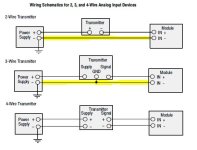fishenguy
Member
I have an AB 1746-NI8, analog input module. Currently there are 4 level sensors connected on channels 0 thru 3. These are using 4-20mA signals from a common power source.
What I want to do is connect two more 4-20mA signals to channels 4 and 5 using another power source.
What has me confused is the instructions:
The following diagram shows typical wiring for the 1746-NI8 module.
• Use shielded communication cable (Belden™ 8761) and keep length as short as
possible.
• Connect only one end of the cable shield to earth ground.
• Connect the shield drain wires for channels 0 to 3 to the top shield terminal.
• Shield terminals are internally connected to chassis ground which is connected to
earth ground via the SLC backplane.
• Single-ended source commons may be jumpered together at the terminal block.
• Channels are not isolated from each other.
• If a different signal source has an analog common, it cannot and must not be
connected to the module.
• Common mode voltage range is ±10.5 volts. The voltage between any two
terminals must be less than 15 volts.
• The module does not provide power for the analog inputs.
• Use a power supply that matches the transmitter (sensor) specifications.
I'm not sure if the underlined sentence pertains to what I'm doing. I'll connect the negitives to the two channels seperatly and also the two positives. I cannot use the same power source because it's comming rom another part of the plant.
Thanks for any help.
Dave
What I want to do is connect two more 4-20mA signals to channels 4 and 5 using another power source.
What has me confused is the instructions:
The following diagram shows typical wiring for the 1746-NI8 module.
• Use shielded communication cable (Belden™ 8761) and keep length as short as
possible.
• Connect only one end of the cable shield to earth ground.
• Connect the shield drain wires for channels 0 to 3 to the top shield terminal.
• Shield terminals are internally connected to chassis ground which is connected to
earth ground via the SLC backplane.
• Single-ended source commons may be jumpered together at the terminal block.
• Channels are not isolated from each other.
• If a different signal source has an analog common, it cannot and must not be
connected to the module.
• Common mode voltage range is ±10.5 volts. The voltage between any two
terminals must be less than 15 volts.
• The module does not provide power for the analog inputs.
• Use a power supply that matches the transmitter (sensor) specifications.
I'm not sure if the underlined sentence pertains to what I'm doing. I'll connect the negitives to the two channels seperatly and also the two positives. I cannot use the same power source because it's comming rom another part of the plant.
Thanks for any help.
Dave



